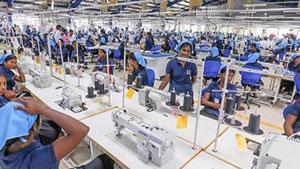Reply To:
Name - Reply Comment
 By Nishel Fernando
By Nishel Fernando
The Joint Apparel Association Forum (JAAF) stressed that the official garment worker minimum wage does not paint an accurate image of the total earnings of a garment worker in Sri Lanka.
Responding to a recent article published on Just-Style, JAAF General Secretary Yohan Lawrence pointed out that the current two-tiered system of a fixed basic wage is complemented by productivity-based payments along with other non-cash benefits.
The Clean Clothes Campaign, the international alliance of labour unions and nongovernmental organisations, claimed that Sri Lanka’s garment industry minimum wage pay scale in general has “failed to cover a worker family’s needs, due to high inflation”.
In March this year, the government increased the national living wage by 40 percent, from Rs.12,500 (US $ 42) to Rs.17,500 (US $ 59) per month, on top of a Rs.3,500 budgetary relief allowance, bringing the total minimum monthly pay to Rs.21,000 (US $ 70). Meanwhile, the apparel sector’s industry-agreed minimum wage, including the government budgetary allowance, stands around Rs.24,000 (US $ 80).
“The article refers to the national minimum wage, which covers the fixed monthly component of employee earnings (the employee’s basic wage). Whilst the national minimum wage was increased after a couple of years, the companies will review the basic wage every year. They will, depending on their ability to pay, increase this basic wage on an annual basis.
The article unfortunately does not make any reference to either the variable components of total earnings (which are paid in cash) or to any of the non-cash benefits afforded to the employees,” Lawrence responded.
The cash benefits include items such as production bonuses, attendance allowances, annual bonuses, skill-based payments and overtime.
“This two-tiered system of a fixed basic wage, complemented by productivity-based payments, has been the norm in all manufacturing industries, both locally and globally,” Lawrence added.
In addition to these cash payments, the industry also provides non-cash benefits such as subsidised meals and transport.
He also noted that several companies also provide subsidised or free dry rations (something that was started at the height of the economic crisis and continues even today) or have other similar schemes to ease the burden of the cost of living on the employees.
Therefore, he argued that it’s unfair to assess the actual level of earnings of the employees merely based on the basic wage.
In addition, Lawrence noted that inflation has come down to single digits since early 2023, after peaking to double digits in 2023, thereby, reducing the inflationary effect on the real wages.
Meanwhile, the JAAF remains confident of reaching US $ 4.5 billion in apparel export earnings this year, despite the challenges.